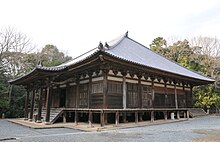Chōkō-ji
The Chōkō-ji ( Japanese 朝 光寺 ) is a temple of the Shingon direction of Buddhism in the district of Hata of the city of Katō in the prefecture of Hyōgo , before 2006 part of the city of Yashiro in the district of Katō .
history
According to the tradition of the temple, the Chōjō-ji was founded in 651 by the Indian priest Hōdō ( 法 道 ). The temple was originally built on the mountain behind it, but was moved to its current location in 1189. - According to documents from 1787, the temple had three sub-temples for training ( 学 侶 , Gakuryo ), 21 Klausen ( 坊 , Bō ) and 5 branch temples ( 末 寺 , Matsuji ). Today only the two sub-temples Kichiyō-in ( 吉祥 院 ) and Sōji-in ( 総 持 院 ) remain. After all, names from Klausen have survived as place names.
The attachment
The main hall ( Hondō ) dates from the Muromachi period and is registered as a national treasure. It has a square floor plan measuring 7 ken × 7 ken , here 19.5 m × 19.5 m. The temple building is a classic example of a "mixed style" building . The hall is divided into an outer ( 外 陣 , Gejin ) and an inner part ( 内 陣 , Naijin ). In the Najin there is a treasure chest ( 宮殿 , Kyūden ) on a base ( 須弥 壇 , Shumidan ) , on the back of which the year “Ōei 20” (1413) can be found, which indicates the relocation here. The roof began in 1418 and the building was completed in 1428. - A circular flat clip is attached to the canopy above the entrance, which is open at the bottom and is called the "crocodile mouth" ( 鰐 口 , Wani-guchi ). You can ring them with a rope and a clapper. It dates from 1285, making it the oldest in the prefecture. In the temple there is a drum ( taiko ), the inscription of which points to the year 1298.
Two wooden Kannon figures, which are registered as an important cultural asset of the prefecture, are venerated . The figure standing in the west dates from 1254. It has the same signature as 23 Kannon figures among the 1001 figures in the Sanjūsangen-dō in Kyoto . The Kannon standing in the east has no signature, but according to its design it should come from the time the temple was founded and thus be the older of the two.
The bell tower ( Shōrō ) is registered as an important cultural asset . It was rebuilt during the Eishō period ( 永 正 ; 1504-1521) by the general Akamatsu Yoshimura ( 赤松 義 村 ; died 1521), as one knows from an inscription in the entablature. The basic structure is executed in the "Japanese style" , which however has typical features from the end of the Kamakura period . The design of the ridge beam is quite unique in Japan.
The treasure pagoda ( Tahōtō ) originally dates from the Bunji period ( 文治 ; 1185–1190). The current one was rebuilt at the request of the daimyo Ikeda Terumasa in 1601 and is registered as an important cultural asset of the prefecture. It is executed in a mixed style, which is typical of the time of construction.
literature
- Hyōgo-ken no rekishi sampo henshu iinkai (ed.): Choko-ji . In: Hyogo-ken no rekishi sampo (ge). Yamakawa Shuppan, 2012. ISBN 978-4-634-24828-1 .
Web links
Coordinates: 34 ° 55 ′ 56.9 ″ N , 135 ° 2 ′ 37.9 ″ E



